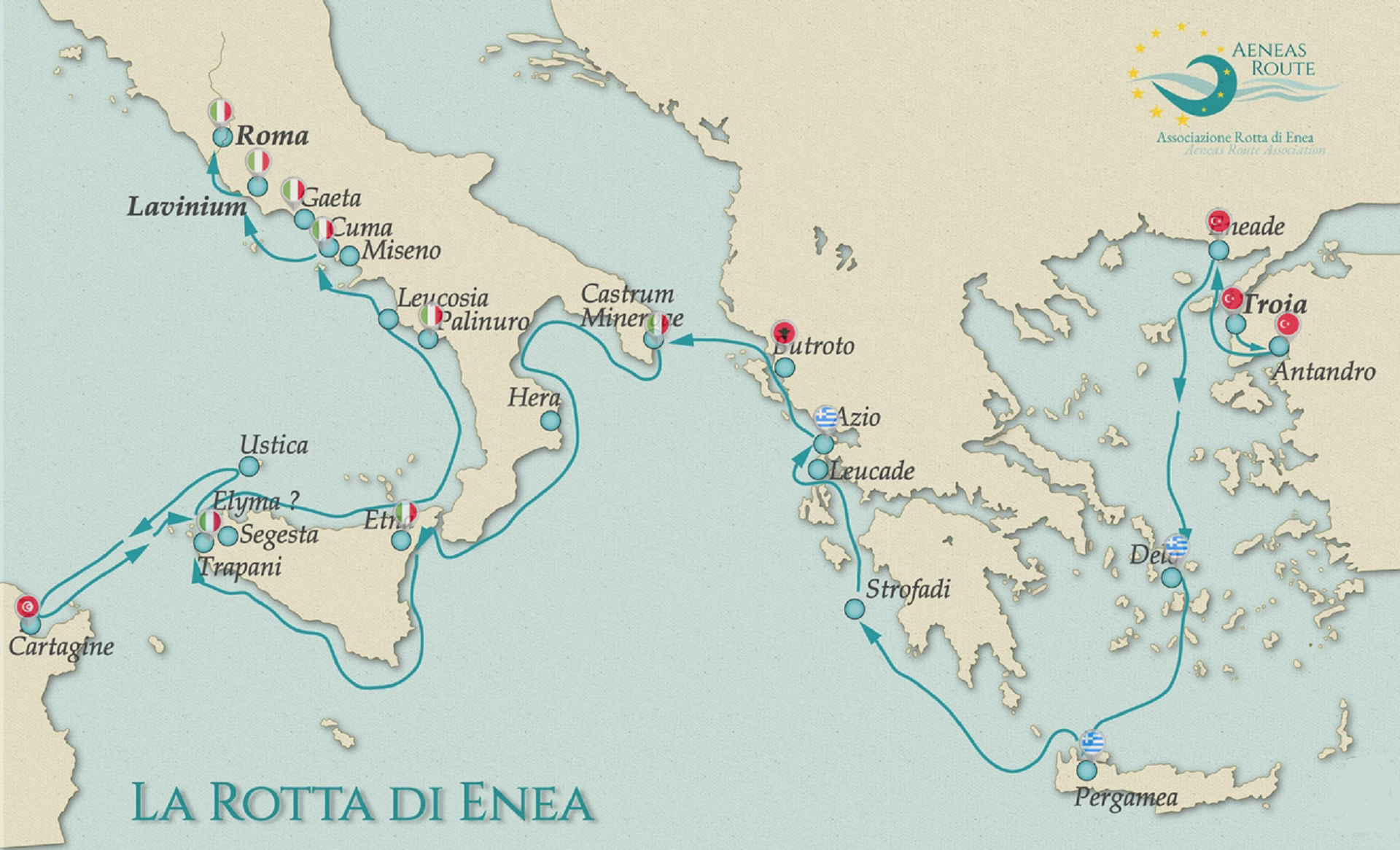THE JOURNEY OF AENEAS
An extraordinary itinerary mixing history and legend, nature and culture
THE JOURNEY OF AENEAS
Aeneas’s journey, recounted in Virgil’s Aeneid, runs from east to west across the Mediterranean. Having escaped from burning Troy, Aeneas set sail from Antandros in Turkey with a small group of companions. After many long wanderings, he reached his destination on the coast of Latium. Here Aeneas founded the city of Lavinium. Aeneas’ son, Ascanius, founded the mythical Alba Longa in the Alban Hills and from his lineage Romulus would be born, as legend would have it, the mythical founder of Rome and its first king.
Aeneas’ journey, made up of many stops in the Mediterranean, touches on five countries – Turkey, Greece, Albania, Tunisia, Italy – and twenty-one locations, including no less than five UNESCO sites (Troy, Delos, Butrint, Carthage, Rome), but also many other extraordinary and fascinating places: Troy, Antandros, Ainos-Enez – in Turkey, Delos, Crete, the Strofades Islands, Lefkada – in Greece, Butrint – in Albania, Castro, Drepana – in Italy, Carthage – in Tunisia, Cumae- Pozzuoli, Gaeta, Lavinium, Rome – in Italy.
The journey undertaken by Aeneas is not only a legend linking the foundation of Rome to the lineage of the Trojan hero, but it is also an ideal journey, because it speaks of the history of man, always ready to move, by choice or by necessity, and to seek new places to call home where peace and prosperity reign, bringing affection and knowledge with him. It is a cultural route, because through its archaeology, nature, and literature it tells a compelling story in which we can all recognise ourselves.

THE STAGES OF THE JOURNEY
Virgil’s story opens with Aeneas and his companions, who, seven years after the fall of Troy, find themselves at the mercy of a violent storm unleashed by the goddess Juno, which leads them to land on the African coast, where they are welcomed by Dido, Queen of Carthage.
Here Aeneas, at the invitation of Dido herself, recounts the adventures he has lived through up to that point and the various stages of his journey, beginning with the night when Troy was destroyed by the Greeks and he and his family were forced to flee in the flames. Thus begins a long series of wanderings across the Mediterranean: from the port of Antandros, from where Aeneas and his family set sail in the ships they had built from the sacred timbers of Mount Ida, to Thrace, and the Island of Delos, where they questioned Apollo’s oracle for clues to the final destination of their journey.
In search of “the ancient mother” – as indicated by Apollo – the small fleet heads for Crete in the Aegean Sea, as Anchises – Aeneas’ father – mistakenly believes that this is the predestined land since the founder of the Trojans was born on that island. The journey continues to the Strofades in the Ionian Sea, and Butrint in Albania, where Aeneas meets Andromache, Hector’s wife. Following an unsuccessful attempt to cross the treacherous strait of Scylla and Charybdis, and after managing to escape an attack by the Cyclops near Mount Etna, Aeneas and his companions arrive at Drepana, at the western end of Sicily, where Anchises – now an old man – dies.
After the long African stopover in Dido’s kingdom, Aeneas’s journey resumes, stopping again in Drepana, Sicily, to celebrate the funeral games in honour of Anchises, exactly one year after his death. After this brief pause, Aeneas and his companions follow the route towards the coast of Latium, passing by Cumae, in Campania. Here, the Trojan hero questions the oracle of the Sibyl to know his future and descends with her into the underworld, where he meets his father Anchises, who foretells him the great destiny that awaits his descendants. From here they return to the sea and finally arrive on the coast of ancient Latium where, following a violent war between Trojans and Latins, Aeneas marries Lavinia – daughter of King Latinus – and founds the ancient city of Lavinium.
Aeneas’s journey in the tale told by Virgil is therefore in direct relation to the heroes and Homeric tale of the Trojan War narrated in the Iliad. But Aeneas is not the hero of strength and cunning. He is the hero of empathy, of the encounter with and the spreading of the Mediterranean culture, which expanded through common to reach much of the then known world. Aeneas’ role in the pathway on which cultural diversities meet thus becomes a symbol of the development of a common European and Mediterranean identity.


